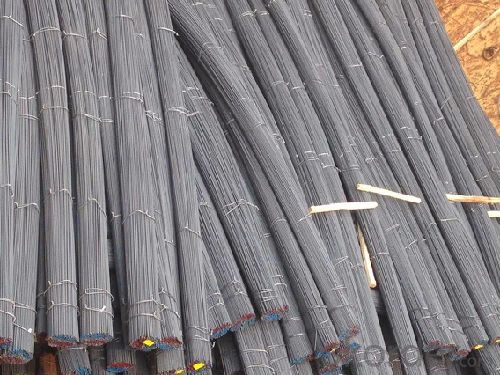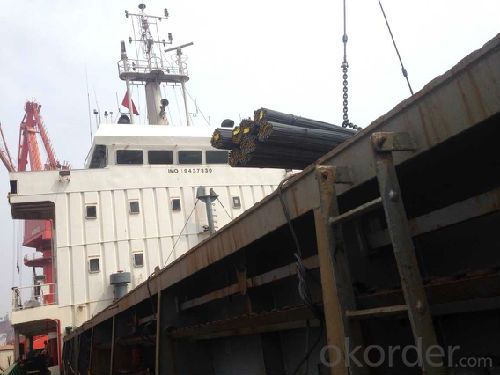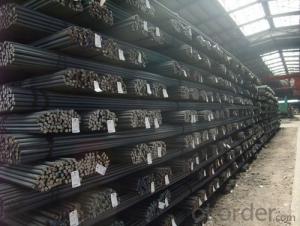Hot Rolled Steel Rebars GB Standard
- Loading Port:
- Tianjin
- Payment Terms:
- TT or LC
- Min Order Qty:
- 50 m.t.
- Supply Capability:
- 100000 m.t./month
OKorder Service Pledge
OKorder Financial Service
You Might Also Like
OKorder is offering Hot Rolled Steel Rebars GB Standard at great prices with worldwide shipping. Our supplier is a world-class manufacturer of steel, with our products utilized the world over. OKorder annually supplies products to African, South American and Asian markets. We provide quotations within 24 hours of receiving an inquiry and guarantee competitive prices.
Product Applications:
Hot Rolled Steel Rebars GB Standard are ideal for structural applications and are widely used in buildings, bridges, roads and other engineering construction. Big to highways, railways, bridges, culverts, tunnels, public facilities such as flood control, dam, small to housing construction, beam, column, wall and the foundation of the plate, deformed bar is an integral structure material..
Product Advantages:
OKorder's Hot Rolled Steel Rebars GB Standard are durable, strong, and wide variety of sizes.
Main Product Features:
· Premium quality
· Prompt delivery & seaworthy packing (30 days after receiving deposit)
· Can be recycled and reused
· Mill test certification
· Professional Service
· Competitive pricing
Product Specifications:
Standard | GB UK USA | HRB335 HRB400 HRB500 G460B, B500A, B500B,B500C GR40, GR60 | |
Diameter | 6mm,8mm,10mm,12mm,14mm,16mm,18mm,20mm, 22mm,25mm,28mm,32mm,36mm,40mm,50mm | ||
Length | 6M, 9M,12M or as required | ||
Invoicing | Actual or Theoretical Weight Basis as buyer’s request. | ||
Type | Hot rolled steel rebar | ||
Diameter(mm) | Section area (mm²) | Mass(kg/m) | Weight of 12m (kg) | Pcs/ton |
6 | 28.27 | 0.222 | 2.664 | 375.38 |
8 | 50.27 | 0.395 | 4.74 | 210.97 |
10 | 78.54 | 0.617 | 7.404 | 135.06 |
12 | 113.1 | 0.888 | 10.656 | 93.84 |
14 | 153.9 | 1.21 | 14.52 | 68.87 |
16 | 201.1 | 1.58 | 18.96 | 52.74 |
18 | 254.5 | 2.00 | 24 | 41.67 |
20 | 314.2 | 2.47 | 29.64 | 33.74 |
22 | 380.1 | 2.98 | 35.76 | 27.96 |
25 | 490.9 | 3.85 | 46.2 | 21.65 |
28 | 615.8 | 4.83 | 57.96 | 17.25 |
32 | 804.2 | 6.31 | 75.72 | 13.21 |
36 | 1018 | 7.99 | 98.88 | 10.43 |
40 | 1257 | 9.87 | 118.44 | 8.44 |
50 | 1964 | 15.42 | 185.04 | 5.40 |
FAQ:
Q1: How many tons of steel products could be loaded in containers?
A1: Usually the steel products are delivered by bulk vessel because of the large quantity and the freight. However, there are no bulk vessel enter some seaports so that we have to deliver the cargo by containers. The 6m steel product can be loaded in 20FT container, but the quantity is changed according to the size, usually from 18tons to 25tons.
Q2: How do we guarantee the quality of our products?
A2: We have established an advanced quality management system which conducts strict quality tests at every step, from raw materials to the final product. At the same time, we provide extensive follow-up service assurances as required.
Q3: How soon can we receive the product after purchase?
A3: Within three days of placing an order, we will arrange production. The normal sizes with the normal grade can be produced within one month. The specific shipping date is dependent upon international and government factors, the delivery to international main port about 45-60days.
Images:


- Q:What are the factors to consider while designing with steel rebars?
- There are several factors to consider when designing with steel rebars, which play a crucial role in ensuring the structural integrity and performance of a construction project. 1. Load capacity: One of the primary factors to consider is the anticipated load capacity of the structure. Steel rebars are designed to provide reinforcement and enhance the tensile strength of concrete. Therefore, the size, spacing, and placement of rebars should be determined based on the expected loads that the structure will be subjected to. 2. Structural requirements: Different structural elements may have specific design requirements. For instance, beams, columns, slabs, and foundations have unique load distribution patterns, and the design of rebars should be tailored to meet these specific needs. The dimensions, quantity, and arrangement of rebars will vary based on the intended structural purpose. 3. Durability: Steel rebars are exposed to various environmental conditions, such as moisture, temperature fluctuations, and chemical exposure. These factors can lead to corrosion, which can significantly impact the strength and longevity of the structure. Therefore, designers need to consider the required level of durability and specify appropriate protective measures, such as using epoxy-coated rebars or providing sufficient concrete cover. 4. Construction methodology: The construction method used for the project can influence the design of steel rebars. Factors such as formwork, construction joints, and accessibility during the placement of rebars need to be taken into account. The design should accommodate the construction process, ensuring ease of installation and proper alignment of rebars. 5. Building codes and regulations: Compliance with local building codes and regulations is crucial to ensure the safety and legality of the structure. Designers must consider the specific requirements outlined in the codes, including minimum rebar sizes, spacing, and cover requirements. Adhering to these standards ensures that the structure meets the necessary safety standards and can withstand potential hazards. 6. Cost-effectiveness: While ensuring structural integrity, it is also essential to consider the cost-effectiveness of the design. Optimizing the placement and arrangement of rebars can help minimize material and labor costs without compromising the safety and performance of the structure. In conclusion, designing with steel rebars involves considering factors such as load capacity, structural requirements, durability, construction methodology, building codes, and cost-effectiveness. By carefully evaluating these factors, designers can create robust, safe, and long-lasting structures.
- Q:How do steel rebars impact the overall energy efficiency of a structure?
- Steel rebars can have both positive and negative impacts on the overall energy efficiency of a structure. On one hand, steel rebars can enhance the structural integrity and durability of the building, leading to a longer lifespan and reduced energy consumption for repairs and maintenance. Additionally, steel rebars can be used to reinforce concrete, which provides better insulation and thermal efficiency. On the other hand, the production of steel rebars requires significant energy and emits greenhouse gases, contributing to the carbon footprint of the structure. Therefore, the overall energy efficiency of a structure depends on various factors, including the design, construction techniques, and the use of sustainable materials alongside steel rebars.
- Q:How are steel rebars bundled and tied together on construction sites?
- Steel rebars, which are commonly used in construction sites to reinforce concrete structures, are bundled and tied together using a specific technique called rebar tying. This process ensures that rebars remain secure and in place during concrete pouring and other construction activities. To bundle rebars, construction workers typically gather a predetermined number of rebars, depending on the project's requirements, and align them parallel to each other. They then use wire or steel straps to tightly bind the rebars together, forming a bundle. The wire or steel straps are wrapped around the rebars at regular intervals, ensuring that the bundle remains compact and the rebars do not shift or separate. Once the rebars are bundled, they are further secured by tying them together using specialized tools. The most common tool used for rebar tying is a rebar tying gun or a rebar tier. This tool automates the process of tying rebars by quickly and efficiently twisting wire around the rebars, creating tight and secure connections. Rebar tying guns or tiers are equipped with a spool of wire that is fed through the tool. The construction worker simply positions the tool over the rebars, presses a trigger or button, and the tool automatically twists the wire around the rebars, tying them together. This process is repeated at regular intervals along the length of the rebars to ensure that they are securely fastened together. The type of wire used for rebar tying is typically a thin, high-tensile steel wire that is strong enough to withstand the forces exerted on the rebars during construction. This wire is specifically designed for rebar tying and is available in pre-cut lengths or on spools. Overall, the bundling and tying of steel rebars on construction sites is a crucial step in ensuring the structural integrity of concrete structures. The use of wire or steel straps, along with specialized rebar tying tools, allows construction workers to create secure and tightly bound bundles of rebars, preventing any movement or separation during construction activities.
- Q:Can steel rebars be used in wind turbine tower construction?
- Yes, steel rebars can be used in wind turbine tower construction. Rebars provide strength and structural support to the tower, ensuring its stability and ability to withstand strong winds.
- Q:Are there any specific guidelines for storing and handling steel rebars?
- Yes, there are specific guidelines for storing and handling steel rebars. These guidelines typically include storing rebars on a flat surface to prevent bending and distortion, keeping them off the ground to prevent rusting, and protecting them from moisture and exposure to chemicals. Additionally, rebars should be handled with care to avoid any damage or injury, and they should be stored in a well-organized manner to ensure easy identification and retrieval.
- Q:How do steel rebars contribute to the seismic performance of a structure?
- Steel rebars contribute to the seismic performance of a structure by enhancing its strength and ductility. When embedded in concrete, rebars act as reinforcement, providing tensile strength to resist the forces generated during an earthquake. This reinforcement helps prevent cracking and failure in the concrete, allowing the structure to better absorb and dissipate seismic energy. Additionally, the flexibility and high yield strength of steel rebars enable them to deform and absorb seismic forces, reducing the likelihood of structural collapse during an earthquake.
- Q:What are the different types of steel rebars used in industrial constructions?
- The different types of steel rebars commonly used in industrial constructions include mild steel rebar, high-strength deformed steel rebar, epoxy-coated steel rebar, stainless steel rebar, and galvanized steel rebar.
- Q:Can steel rebars be bent on site?
- Yes, steel rebars can be bent on site.
- Q:What is the diameter of the cross section of the threaded steel?
- The cross section of a threaded steel is a circle, and the diameter of any line passing through the center of the circle is the diameter.
- Q:Can steel rebars be used in the construction of offshore wind farms?
- Yes, steel rebars can be used in the construction of offshore wind farms. Steel rebars are commonly used in the construction industry to reinforce concrete structures, and they can also be utilized in offshore wind farm installations. The durability and strength of steel rebars make them suitable for withstanding the harsh marine environment and supporting the foundations of offshore wind turbines.
1. Manufacturer Overview |
|
|---|---|
| Location | |
| Year Established | |
| Annual Output Value | |
| Main Markets | |
| Company Certifications | |
2. Manufacturer Certificates |
|
|---|---|
| a) Certification Name | |
| Range | |
| Reference | |
| Validity Period | |
3. Manufacturer Capability |
|
|---|---|
| a)Trade Capacity | |
| Nearest Port | |
| Export Percentage | |
| No.of Employees in Trade Department | |
| Language Spoken: | |
| b)Factory Information | |
| Factory Size: | |
| No. of Production Lines | |
| Contract Manufacturing | |
| Product Price Range | |
Send your message to us
Hot Rolled Steel Rebars GB Standard
- Loading Port:
- Tianjin
- Payment Terms:
- TT or LC
- Min Order Qty:
- 50 m.t.
- Supply Capability:
- 100000 m.t./month
OKorder Service Pledge
OKorder Financial Service
Similar products
New products
Hot products
Related keywords





























